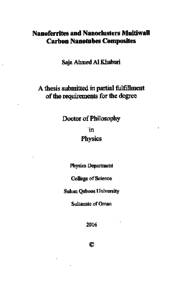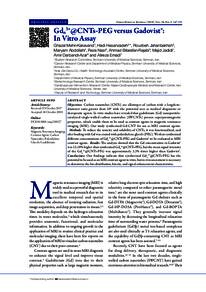وثيقة
Implementation of molecular dynamics simulation and hierarchical multiscale modeling to investigate the mechanical characteristics of carbon nanotube reinforced aluminum-copper alloy nanocomposite.
المصدر
Doctoral dissertation
عناوين أخرى
دراسة الخصائص الميكانيكية لمركب نانوي من سبائك الألمنيوم والنحاس المدعم بأنابيب الكربون النانوية عن طريق استخدام محاكاة الجزيئات الديناميكية والمحاكاة الهرمية متعددة النطاقات
الدولة
Oman
مكان النشر
Muscat
الناشر
Sultan Qaboos University
ميلادي
2024
اللغة
الأنجليزية
الموضوع
نوع الرسالة الجامعية
Doctoral dissertation
الملخص الإنجليزي
Aluminum alloys and aluminum-based composites possess a unique set of properties
making them excellent candidates for many applications in structural, aerospace,
automobile, defense, high-tech industries, etc. Among all aluminum alloys, aluminumcopper ‘Al-Cu’ alloy has the highest strength and hardness at elevated temperatures.
Hence it was the topic of interest of many researchers leading to a wide data reported for
its potential functions’ parameters. Yet, the increase in the stiffness is minimized and
needs to be enhanced by reinforcing it with other materials like carbon nanomaterial and
developing metal-based composites. Carbon nanotubes ‘CNTs’ due to their novel
properties have attracted a great deal of interest as a reinforcement in polymeric, ceramics
and metal-based composites. Numerical investigation through the use of molecular
dynamics simulation ‘MD’ and hierarchical multiscale modeling are used for the first
time to study the mechanical properties of aluminum-copper alloy reinforced with carbon
nanotube nanocomposite ‘Al-Cu/CNT’. The aim is to investigate the mechanical
properties of the nanocomposite at the atomistic scale using MD simulation then use
hierarchical multiscale techniques to scale up the properties by homogenization to the
microscale and use finite element method ‘FEM’ to find the properties of the
nanocomposite at the microscale.
A molecular dynamics simulation model was created to examine the mechanical
properties of Al-Cu/CNT nanocomposite using the open-source software LAMMPS. To
start with, the model was validated by creating two MD models and comparing their
results to results published in the literature. The first model was for aluminum reinforced
with CNT ‘Al/CNT’, and the second model was for aluminum copper alloy 'Al-Cu’.
Visual molecular dynamics ‘VMD’ software was used to create the structure of the CNT,
whereas LAMMPS software was used to create the structure of the Al and Al-Cu matrices.
To fully understand the mechanical properties of the nanocomposite, a parametric study
was conducted where the mechanical properties of the nanocomposite were studied under
the influence of several parameters. Those parameters include the size of the CNT,
volume fraction of the CNT, structure of the CNT (armchair, zigzag, and chiral), aspect
ratio (length to diameter ratio) of the CNT, and applied strain rate. Additionally, the effect
of material distribution of Al-Cu alloy on the mechanical properties of the nanocomposite
was considered by functionally grading the alloy. All the above parameters are studied
independently of each other, meaning that when the effect of the size of the CNT for
example is considered all other parameters are kept fixed. This is done to ensure that the
change in the mechanical properties is only due to that parameter. The volume fraction of
the CNT was increased from 1% to 10% for a nanocomposite with a 10% alloying of Cu
reinforced with an armchair CNT having a chirality of (6,6). The modulus of elasticity
and the failure strength were found to increase remarkably as the volume fraction
increased but no change was noticed on the failure strain of the nanocomposite. An
increase of 76% and 150% in the modulus of elasticity and the failure strength,
respectively, were observed as the volume fraction increased from 1% to 10%. By
increasing the size of the CNT and hence increasing its diameter, the modulus of elasticity
and the failure strain were both found to decrease along with the yield and failure
strengths. A decrease of almost 30.8% and 32.6% were calculated for the yield and failure
strengths, respectively, as the size of the CNT increased from (6,6) to (12,12). The failure
behavior was observed to vary with respect to the structure of the CNT. Both the armchair
and zigzag CNTs exhibited a similar behavior where a sudden failure of the
nanocomposite was observed, whereas in the chiral CNT, the failure was gradual. The
nanocomposite with the armchair CNT was found to have the highest modulus of
elasticity and failure strain. Regarding the aspect ratio and the applied strain, no
significant difference was noticed in the modulus of elasticity of the nanocomposite due
to either. A very slight increase was noticed in the failure strain as the applied strain rate
was increased. Furthermore, sigmoid distribution was used to functionally grade the AlCu alloy in the longitudinal direction, and the molecular dynamics results revealed that
the material distribution has almost no effect on the mechanical properties of the
nanocomposite.
A hierarchical multiscale simulation method was then used to find the mechanical
properties of the Al-Cu alloy reinforced with a (6,6) armchair carbon nanotube
nanocomposite at the microscale. Molecular dynamics simulation using LAMMPS
software was first used to calculate the five mechanical properties of the nanocomposites
namely, the longitudinal ‘EL’ and transverse ‘Ex’ moduli of elasticity, the Poisson’s ratios
in x-y ‘𝜈xy’ and x-z planes ‘𝜈xz’, and the shear modulus ‘G’. The Al-Cu/CNT
nanocomposite was then homogenized into an equivalent fiber with the exact same
structure and properties, where the latter was embedded in multiple numbers following a
hexagonal arrangement into an Al-Cu matrix with 10% alloying. Perfect bonding between
the equivalent fiber and the matrix was assumed. The finite element method was then
implemented on a representative volume element ‘RVE’ to find the five mechanical
properties of the nanocomposite (EL, Ex, 𝜈xy, 𝜈xz, G) at the microscale under the effect of
the volume fraction of the CNT using APDL ANSYS software. Results showed that the
longitudinal modulus of elasticity along with the Poison’s ratios in the x-y and x-z planes
increased as the volume fraction of the CNT increased. However, both the transvers
modulus of elasticity and the shear modulus exhibited a very slight decrease in their value
as the volume fraction of the CNT increased.
الملخص العربي
تتمتع سبائك الألومنيوم والمواد المركبة القائمة على الألومنيوم بمجموعة من الخصائص الفريدة التي تجعلها مرشحة ممتازة في مجال الصناعات الهيكلية، وصناعات السيارات، والصناعات في مجال الجو والدفاع، والصناعات التكنلوجية المتطورة هذا وبالإضافة إلى غيرها من المجالات. من بين العديد من سبائك الألمنيوم، تتميز سبائك الألمنيوم والنحاس ) C-Al )بامتلاكها أعلى معدل قوة تحمل وصلابة في درجات الحرارة المرتفعة، مما جعلها موضوع اهتمام العديد من الباحثين، الأمر الذي أدى إلى توفر بيانات واسعة حول قيم الوظائف الكامنة. على الرغم مما ذكر، تعد الزيادة في مستوى الصلابة الميكانيكية في سبائك الألمنيوم والنحاس محدودة وتحتاج إلى التعزيز من خلال تدعيم المادة بمواد أخرى مثل المواد الكربونية النانوية )CNTs )مما ينتج عنه تطوير المواد المركبة القائمة على المعادن. ً جذبت أنابيب الكربون النانوية بسبب خصائصها المميزة اهتماما كبيرا كعامل تعزيز في المواد المركبة البوليمرية والسيراميكية والمواد المركبة القائمة على المعادن. في هذا البحث ولأول مرة تم اعتماد طرق الحسابات العددية من خلال استخدام محاكاة الجزيئات الديناميكية )MD )والمحاكاة الهرمية متعددة النطاقات لغرض دراسة الخصائص الميكانيكية لمركب نانوي من سبائك الألمنيوم والنحاس المدعم بأنابيب الكربون النانوية )CNT/Cu-Al). الهدف من هذه الدراسة هو حساب الخصائص الميكانيكية للمادة النانوية المركبة في المقياس الذري من خلال استخدام محاكاة الجزيئات الديناميكية ومن ثم توظيف المحاكاة الهرمية متعددة النطاقات لتحويل هذه الخصائص إلى المقياس المجهري من خلال استخدام تقنية التجانس يليها استخدام طريقة العناصر المحدودة .)FEM( لتحقيق الهدف من الدراسة، تم ابتكار نموذج عددي باستخدام محاكاة الجزيئات الديناميكية لدراسة الخصائص الميكانيكية للمركب النانوي CNT/Cu-Al باستخدام برنامج LAMMPS. تم التصديق على صحة النموذج من خلال ابتكار نموذجين احداهما لسبائك الألمنيوم مع النحاس والآخر لمركب نانوي من الألمنيوم المدعم بأنابيب كربون نانوية، ومقارنة نتائج المحاكاة لهذين النموذجين مع نتائج دراسات نشرت سابقا في المجلات العلمية. لإنشاء هيكل أنبوب الكربون النانوية، تم اعتماد برنامج VMD، بينما تم استخدام برنامج LAMMPSلإنشاء هيكل سبائك الالمنيوم والنحاس بالإضافة إلى هيكل الألمنيوم. للتمكن من فهم الخصائص الميكانيكية للمركب النانوي CNT/Cu-Al بشكل واسع، تم اجراء دراسة معملية تعنى بدراسة تأثير عدد من العوامل على الخصائص الميكانيكية للمركب النانوي. تتضمن هذه العوامل حجم أنبوب الكربون النانوي، ونسبة حجم أنبوب الكربون النانوي مقارنة بحجم مصفوفة سبائك الألمنيوم والنحاس، وبنية أنبوب الكربون النانوي )من نوع الكرسي، والمتعرج ، و الكيرالي(، و نسبة الشكل لأنبوب الكربون النانوي )نسبة الطول إلى القطر(، و معدل التمدد المطبق. إضافة إلى هذا، تم دراسة تأثير توزيع المادة في سبائك الألمنيوم والنحاس على الخصائص الميكانيكية للمركب النانوي CNTمن خلال تدريج تركيز المادة طوليا في مصفوفة سبائك الألمنيوم والنحاس. جميع هذه الخصائص تم دراستها بصورة مستقلة عن بعضها، فعندما تم النظر على سبيل المثال في تأثير حجم x الأنبوب النانوي فقد تم تثبيت جميع العوامل الأخرى، وذلك لضمان انه التغير في الخصائص الميكانيكية للمركب النانوي ناتج بتأثير من هذا العامل فقط. في بداية الأمر، تم تقوية سبائك الألمنيوم والنحاس بأنبوب الكربون النانوي على شكل الكرسي وبعامل كيرالي (6,6)، وعند زيادة نسبة حجم أنبوب الكربون النانوي CNT لحجم مصفوفة سبائك الألمنيوم والنحاس من 1إلى ,%10 فقد وجدت زيادة ملحوظة بمعامل المرونة وقوة فشل المركب النانوي بنسبة %76 و %150 على التوالي، بينما لم يلحظ أي تغير في إجهاد الفشل. بعد هذا تم زيادة ً حجم قطر أنبوب الكربون النانوي، ووجد ا إلى جنب أن معامل المرونة وإجهاد الفشل قد انخفضا جنب مع قوى الخضوع والفشل. حيث تم حساب نسبة الانخفاض بحوالي %30.8 و %32.6 لقوى الخضوع والفشل على التوالي وذلك مع زيادة حجم أنبوب الكربون النانوي من (6,6) إلى (12,12). إضافة إلى هذا فقد تم الاستنتاج بأن بنية أنبوب الكربون النانوي لها تأثير ملحوظ على سلوك الفشل للمركب النانوي، حيث أظهرت كل من الأنابيب النانوية الكربونية على شكل كرسي بذراعين والمتعرجة سلوكًا ا حيث لوحظ فشل مفاجئ للم ً مشابه ركب النانوي، بينما في الأنابيب النانوية الكربونية الكيرالية، كان ا ً الفشل تدريجي . وجد أيضا ان المركب النانوي المقوى بأنبوب الكربون النانوي على شكل كرسي قد سجل أعلى معامل مرونة واجهاد الفشل. فيما يتعلق بنسبة العرض إلى الطول ومعدل التمدد المطبق لاحظ فرق كبير في معامل المرونة للمركب النانوي بسبب أي منهما ُ ، لم ي وتم ملاحظة زيادة طفيفة ج ًد تمدد المطبق. بالإضافة إلى ذلك، تم استخدام توزيع ا في إجهاد الفشل مع زيادة معدل ال سيجمويد(Sigmoid (لتصنيف سبائك الألومنيوم و النحاس بتغير تركيز المادة في الاتجاه الطولي، وكشفت النتائج أن توزيع المادة ليس له تأثير يذكر على الخصائص الميكانيكية للمركب النانوي. في خطوة لاحقة، تم استخدام الطريقة الهرمية متعددة النطاقات لإيجاد الخصائص الميكانيكية في المستوى المجهري للمركب النانوي المكون من سبائك الألمنيوم المدعمة بأنبوب الكربون النانوية على شكل الكرسي بعامل كيرالي (6,6). حيث تم استخدام محاكاة الجزيئات الديناميكية أولا باستخدام برنامج LAMMPSلإيجاد الخصائص الميكانيكية الخمسة للمركب النانوية وهي: معامل المرونة الطولي (EL (ومعامل المرونة العرض (Ex (، ونسب بويزنوس ratios s’Poison) xy 𝜈,xz(𝜈في المستويات(y-x (و (z-x (و معامل الصلابة (G(. ثانيا, تم مجانسة المركب النانوي إلى الياف مكافئة بنفس الهيكلية و الخصائص الميكانيكية و تم غرسها في مصفوفة سبائك الألمنيوم و النحاس بتنسيق سداسي, كما تم افتراض تطابق مثالي بين المصفوفة و الألياف المتكافئة. ثالثا، تم حساب الخصائص الميكانيكية الخمسة للمركب النانوي (G ,xz 𝜈,xy 𝜈,Ex ,EL (على المستوى المجهري باستخدام طريقة العناصر المحدودة FEM على عنصر تمثيلي RVE تحت تأثير نسبة حجم أنبوب الكربون النانوي باستخدام برنامج ANSYS APDL. أظهرت النتائج أن معامل المرونة الطولي ونسب بويزنوس في المستويات(y-x (و (z-x (زادت مع زيادة نسبة حجم الأنبوب النانوي الكربوني، بينما، أظهر كل من نسبة حجم معامل المرونة العرضي ومعامل الصلابة انخفاضا طفيفا جدا في قيمتهما مع زيادة انخفاضً الأنبوب النانوي الكربوني.
قالب العنصر
الرسائل والأطروحات الجامعية



